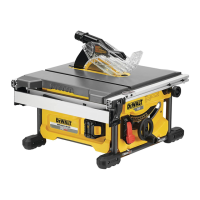9
ENGLISH
g ) Use the power tool, accessories and tool bits etc.,
in accordance with these instructions taking into
account the working conditions and the work to be
performed. Use of the power tool for operations different
from those intended could result in a hazardoussituation.
h ) Keep handles and grasping surfaces dry, clean and
free from oil and grease. Slippery handles and grasping
surfaces do not allow for safe handling and control of the
tool in unexpectedsituations.
5) Battery tool use and care
a ) Recharge only with the charger specified by the
manufacturer. A charger that is suitable for one type
of battery pack may create a risk of fire when used with
another batterypack.
b ) Use power tools only with specifically designated
battery packs. Use of any other battery packs may create
a risk of injury andfire.
c ) When battery pack is not in use, keep it away from
other metal objects like paper clips, coins, keys,
nails, screws or other small metal objects that can
make a connection from one terminal to another.
Shorting the battery terminals together may cause burns
or afire.
d ) Under abusive conditions, liquid may be ejected
from the battery; avoid contact. If contact
accidentally occurs, flush with water. If liquid
contacts eyes, additionally seek medical help. Liquid
ejected from the battery may cause irritation orburns.
e ) Do not use a battery pack or tool that is damaged or
modified. Damaged or modified batteries may exhibit
unpredictable behaviour resulting in fire, explosion or risk
ofinjury.
f ) Do not expose a battery pack or tool to fire or
excessive temperature. Exposure to fire or temperature
above 130 °C may causeexplosion.
g ) Follow all charging instructions and do not charge
the battery pack or tool outside the temperature
range specified in the instructions. Charging
improperly or at temperatures outside the specified range
may damage the battery and increase the risk offire.
6) Service
a ) Have your power tool serviced by a qualified repair
person using only identical replacement parts. This
will ensure that the safety of the power tool ismaintained.
b ) Never service damaged battery packs. Service
of battery packs should only be performed by the
manufacturer or authorized serviceproviders.
Safety Instructions for Table Saws
1) Guarding Related Warnings
a ) Keep guards in place. Guards must be in working
order and be properly mounted. Aguard that is loose,
damaged, or is not functioning correctly must be repaired
orreplaced.
b ) Always use saw blade guard, riving knife for every
through–cutting operation. For through-cutting
operations where the saw blade cuts completely through
the thickness of the workpiece, the guard and other safety
devices help reduce the risk ofinjury.
c ) Immediately reattach the guarding system after
completing an operation (such as rabbeting or
resawing cuts) which requires removal of the guard
or riving knife. The guard and riving knife help to reduce
the risk ofinjury.
d ) Make sure the saw blade is not contacting the guard,
riving knife or the workpiece before the switch is
turned on. Inadvertent contact of these items with the
saw blade could cause a hazardouscondition.
e ) Adjust the riving knife as described in this instruction
manual. Incorrect spacing, positioning and alignment
can make the riving knife ineffective in reducing the
likelihood ofkickback.
f ) For the riving knife to work, they must be engaged in
the workpiece. The riving knife is ineffective when cutting
workpieces that are too short to be engaged with the
riving knife. Under these conditions a kickback cannot be
prevented by the riving knife .
g ) Use the appropriate saw blade for the riving knife.
For the riving knife to function properly, the saw blade
diameter must match the appropriate riving knife and the
body of the saw blade must be thinner than the thickness
of the riving knife and the cutting width of the saw blade
must be wider than the thickness of the rivingknife.
2) Cutting Procedures Warnings
a ) DANGER: Never place your fingers or hands in
the vicinity or in line with the saw blade.
Amoment of inattention or a slip could direct your hand
towards the saw blade and result in serious
personalinjury.
b ) Feed the workpiece into the saw blade only against
the direction of rotation. Feeding the workpiece in the
same direction that the saw blade is rotating above the
table may result in the workpiece, and your hand, being
pulled into the sawblade.
c ) Never use the mitre gauge to feed the workpiece
when ripping and do not use the rip fence as a
length stop when cross cutting with the mitre gauge.
Guiding the workpiece with the rip fence and the mitre
gauge at the same time increases the likelihood of saw
blade binding andkickback.
d ) When ripping, always apply the workpiece feeding
force between the fence and the saw blade. Use a
push stick when the distance between the fence and
the saw blade is less than 150 mm, and use a push
block when this distance is less than 50 mm. “Work
helping” devices will keep your hand at a safe distance
from the saw blade.
e ) Use only the push stick provided by the
manufacturer or constructed in accordance with the
Ташев-Галвинг ООД
www.tashev-galving.com

